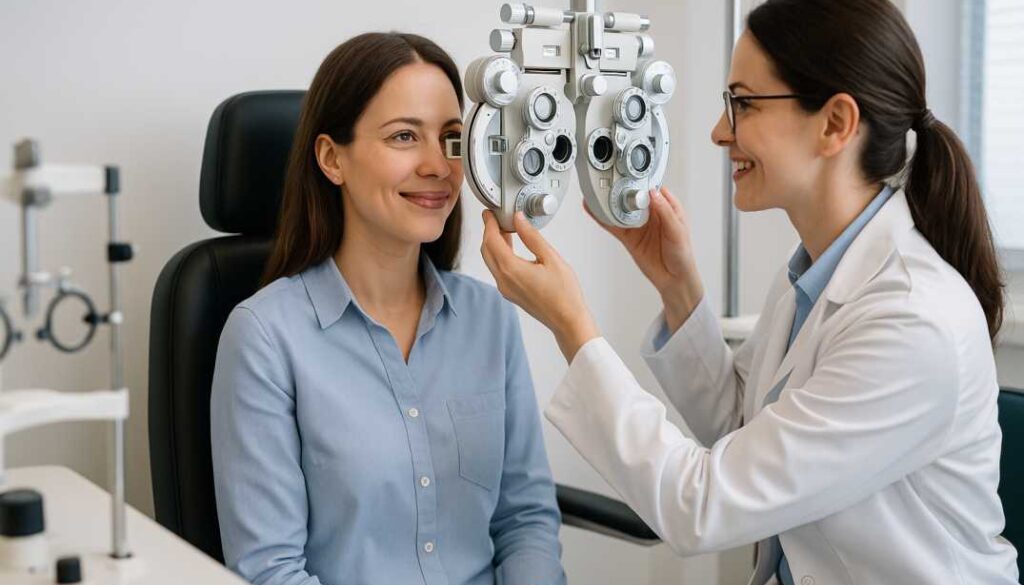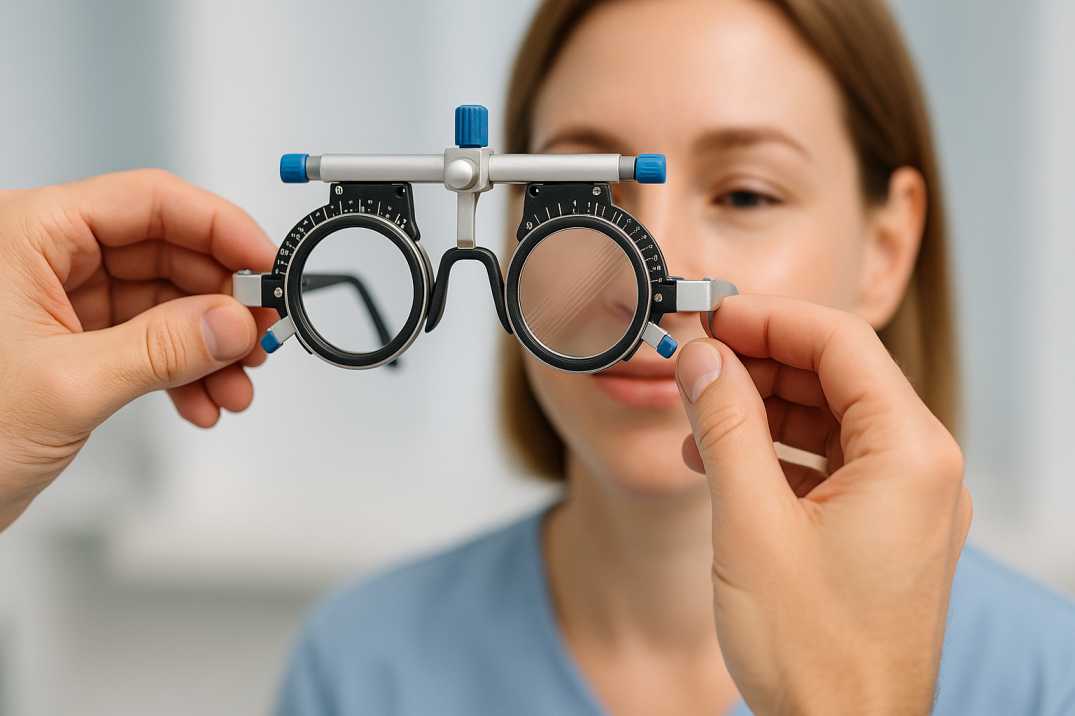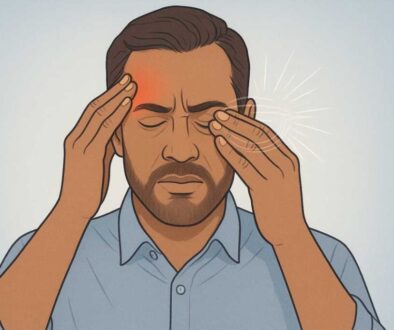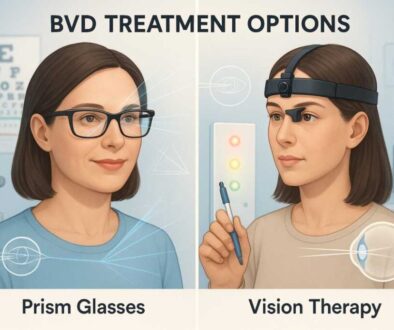BVD Diagnosis: What to Expect During Testing

Quick Answer: BVD diagnosis involves a specialized NeuroVisual™ examination that takes 1.5 to 3 hours and includes a symptom questionnaire, comprehensive eye alignment testing, and trial lens fitting. Most patients experience immediate 50% symptom relief during their first visit when fitted with microprism lenses.
If you’ve been struggling with unexplained headaches, dizziness, or reading difficulties for years—visiting specialist after specialist without answers—you’re not alone. Many people suffering from Binocular Vision Dysfunction (BVD) spend years being misdiagnosed with migraines, anxiety, ADHD, or even inner ear problems.
The frustrating truth? Standard eye exams typically miss BVD diagnosis entirely, even if you have perfect 20/20 vision.
This comprehensive guide walks you through exactly what to expect during BVD diagnosis testing, from the initial screening to the moment you might finally experience relief.
Understanding BVD Diagnosis: Why Standard Eye Exams Miss It
The key to understanding BVD diagnosis lies in recognizing what traditional eye exams actually measure. Most routine vision testing focuses on visual acuity—how clearly each eye can see letters on a chart. But binocular vision dysfunction diagnosis isn’t about how well you see; it’s about how well your two eyes work together as a coordinated team.
The Difference Between Vision Clarity and Eye Coordination
When you visit a regular optometrist for glasses or contacts, they examine each eye separately to determine if you’re nearsighted, farsighted, or have astigmatism. These measurements tell us nothing about eye alignment, convergence ability, or binocular coordination. During a standard exam, each eye might test perfectly at 20/20, yet your eyes could still be misaligned by tiny amounts—as small as a fraction of a millimeter—causing your brain and eye muscles to work overtime to compensate.
This constant overcompensation creates the debilitating symptoms associated with BVD:
- Chronic headaches
- Neck tension
- Balance problems
- Anxiety in large spaces
- Reading fatigue
- Motion sickness
The misalignment is often so subtle that it’s invisible to the naked eye and won’t show up on typical vision screening equipment.
Why 20/20 Vision Doesn’t Rule Out BVD Diagnosis
One of the most common misconceptions about BVD diagnosis is that people with excellent vision can’t have this condition. In reality, having sharp, clear vision in each eye tells us absolutely nothing about binocular function. The specialized testing required for accurate BVD diagnosis evaluates eye teaming, tracking, focusing flexibility, and the alignment between both eyes—measurements that simply aren’t part of standard vision care.
This is why so many patients report being told by multiple eye doctors that “your eyes are fine” despite experiencing severe visual symptoms. Their eyes may indeed see clearly, but the coordination system connecting both eyes and the brain is dysfunctional. Proper BVD diagnosis requires specialized neurovisual testing that goes far beyond routine eye examinations.
Before Your BVD Evaluation: How to Prepare
Proper preparation can help you get the most accurate diagnosis and make your BVD testing experience more productive. A comprehensive neurovisual examination typically takes between 1.5 and 3 hours, so it’s important to plan accordingly.
What to Bring to Your Appointment
Essential Items:
- Current eyeglasses or contact lenses prescription
- List of all current medications (some can affect eye muscle function)
- Completed symptom questionnaire (often sent ahead of time)
- Medical records from previous specialists you’ve consulted
- Insurance card and photo ID
- A friend or family member to drive you home (dilation may be involved)
Pro Tip: Bring a notebook to jot down instructions and questions during your appointment. The amount of information can be overwhelming, and you’ll want to remember key details about your diagnosis and treatment plan.
Questions to Ask Your Doctor
Come prepared with specific questions about your symptoms and concerns. Be ready to describe exactly when symptoms occur, what makes them worse, and what provides relief.
Important topics to discuss:
- How long have you experienced symptoms
- Previous diagnoses or treatments tried
- Family history of vision problems
- Any head injuries, concussions, or traumatic events
- Specific activities that trigger discomfort (reading, driving, scrolling on phone)
The more detailed information you provide, the more accurate your BVD diagnosis will be.
What to Avoid Before Testing
For the most accurate BVD diagnosis results, follow these guidelines:
24 Hours Before Your Appointment:
- Get a good night’s sleep (7-8 hours recommended)
- Eat a proper meal before your appointment
- Avoid caffeine on the day of testing (it can affect eye muscle performance)
- Don’t skip doses of regular medications unless specifically instructed
- Arrive relaxed and not rushed—allow extra time for parking and check-in
Important: If you wear contact lenses, ask your provider whether to wear them or bring glasses instead. Some testing is easier to perform with glasses.
The BVD Screening Process: Your First Step
Most BVD diagnosis journeys begin with a validated screening tool called the Binocular Vision Dysfunction Questionnaire (BVDQ). This scientifically developed assessment helps identify individuals who are most likely to benefit from a full neurovisual evaluation.
The BVDQ Questionnaire Explained
The BVDQ asks detailed questions across seven main symptom categories:
- Headaches and migraines – Frequency, location, and triggers
- Dizziness and balance issues – Episodes of vertigo or unsteadiness
- Reading and learning challenges – Comprehension difficulties, losing place on the page
- Anxiety in certain environments – Overwhelm in crowds, malls, or while driving
- Neck pain and shoulder tension – Chronic discomfort from compensatory posture
- Light sensitivity – Difficulty with bright lights or glare
- Motion sickness and nausea – Car sickness, discomfort with movement
For children ages 4 to 8, a parent-assisted version takes about 6 minutes to complete. Older children (9+) and adults can complete the assessment independently in approximately 7 minutes. The questions measure both frequency and severity of symptoms to create a comprehensive picture of how vision dysfunction may be affecting your daily life.
Understanding Your Symptom Score
Once you submit the BVDQ, you’ll receive a BVDQ™ score instantly. This score is compared against validated thresholds (which vary by age group) to determine the likelihood of BVD.
What Your Score Means:
High Score (Above Threshold): You’ll typically qualify for a free virtual consultation with a BVD specialist who can discuss your symptoms in more detail and determine if a full neurovisual examination is recommended.
Low Score (Below Threshold): Your symptoms may stem from another condition. You’ll receive recommendations for other specialists to consider and guidance on the next diagnostic steps.
The BVDQ has been scientifically validated with excellent reliability, making it a trusted first step in the BVD diagnosis journey.
What Happens After the Online Assessment
What happens next:
- Virtual consultation: Discussion of your specific symptoms and medical history
- Appointment scheduling: Booking your comprehensive neurovisual evaluation
- Additional information gathering: You may be asked for more details about symptom patterns
- Insurance verification: Understanding coverage for specialized testing
- Preparation guidance: Specific instructions for your evaluation appointment
If your screening doesn’t indicate BVD, you’ll typically receive recommendations for other specialists who might help identify the true cause of your symptoms. Either way, the screening provides valuable direction for your healthcare journey.
The Complete NeuroVisual Examination: Step-by-Step
The comprehensive BVD diagnosis evaluation goes far beyond what you’d experience in a typical eye exam. This specialized testing is designed to detect even the smallest eye misalignments and assess how your entire visual system functions.
Comprehensive Medical History Review
Your neurovisual specialist will begin with an in-depth discussion of your symptoms, medical history, and prior treatments. This conversation helps rule out other potential causes and provides context for your test results. Be prepared to discuss:
- Timeline of symptom development
- Previous diagnoses (migraines, anxiety, ADHD, vestibular disorders)
- Traumatic brain injuries or concussions
- Family vision history
- Medications and supplements
- Impact on daily activities, work, and quality of life
Standard Vision Testing (Refraction)
Even though BVD isn’t about visual acuity, your examination will include traditional refraction testing to determine if you need correction for nearsightedness, farsightedness, or astigmatism. This baseline measurement ensures that any vision clarity issues are addressed separately from the binocular dysfunction assessment.
Specialized Binocular Vision Tests
This is where BVD diagnosis truly begins. Your specialist will perform a comprehensive series of tests that standard optometrists rarely conduct:
Cover Test: The practitioner alternately covers each eye while you focus on a distant object. This reveals any eye movement as your brain attempts to maintain fixation, indicating misalignment. The cover-uncover test is one of the most fundamental assessments for detecting heterophoria.
Eye Alignment Measurement: Using specialized equipment and prism lenses, the doctor measures the exact degree of vertical, horizontal, or oblique misalignment between your eyes. These measurements can detect discrepancies as small as a fraction of a prism diopter—far too subtle for standard equipment.
Convergence and Divergence Testing: These tests evaluate your ability to turn both eyes inward (when looking at something close) and outward (when shifting gaze to distance). Difficulty with convergence often causes reading problems and near-work fatigue.
Accommodation Testing: This measures how well your eyes shift focus between distances and how quickly they can adjust. Poor accommodative flexibility commonly accompanies BVD and contributes to visual fatigue.
Visual Tracking Assessment: Your eye movements are evaluated as you follow moving targets. Smooth, coordinated tracking is essential for reading, sports, and navigating your environment. Patients with BVD often display jerky or uncoordinated eye movements.
Binocular Fusion Evaluation: This sophisticated testing determines how effectively your brain combines the images from both eyes into a single, unified picture. Weak fusion abilities force the visual system to work constantly to maintain single vision.
Physical Coordination Evaluation
Because BVD affects the entire body’s sense of balance and spatial orientation, comprehensive testing includes assessments beyond just the eyes:
- Posture analysis: Many BVD patients unconsciously tilt their heads to compensate for vertical misalignment
- Balance testing: Evaluation of how vision affects your equilibrium and stability
- Gait observation: Walking patterns can reveal visual-vestibular integration problems
- Head positioning: Documentation of any compensatory head turns or tilts
Trial Lens Fitting: The Moment of Relief
If your BVD diagnosis testing reveals misalignment, your specialist will immediately fit you with custom trial lenses containing precisely calculated microprism correction. This is often the most dramatic—and emotional—part of the evaluation.
For many patients, it’s a life-changing moment.
How Microprism Lenses Work
Microprism lenses contain extremely small amounts of prism (measured in prism diopters) that are precisely ground into the lens material. These specialized lenses gently bend incoming light before it enters your eyes, effectively realigning the images so both eyes send a single, coordinated message to your brain.
The “micro” refers to the very small prism measurements required—often less than one prism diopter vertically and sometimes combined with horizontal correction. Standard prisms used for other eye conditions are typically much larger and more noticeable.
Immediate Symptom Improvement
For patients with BVD, the response to trial lenses is typically rapid and remarkable. Many people report:
- Headache relief within minutes – Pressure and pain simply disappear
- Sudden clarity and visual comfort – The world looks “right” for the first time
- Reduced dizziness or improved balance – Steadiness returns immediately
- Easier reading and focus – Words stop moving on the page
- An overwhelming sense of relief – Finally, validation and answers
Studies show that approximately 50% of BVD patients experience noticeable symptom reduction during their very first visit with trial lenses. This immediate response serves as a powerful confirmation of the BVD diagnosis.
If realigning your eyes eliminates symptoms within minutes, the visual system was clearly the source of your problems.
Confirming Your BVD Diagnosis
Your BVD diagnosis is confirmed through a combination of:
- Objective findings: Measurable misalignment detected during testing
- Subjective response: Your reported symptom improvement with trial lenses
- Functional improvement: Observable changes in posture, balance, or reading ability
Both the measurements and your personal experience matter equally in confirming BVD and determining the appropriate treatment plan.
Understanding Your BVD Test Results
After completing comprehensive testing, your specialist will review all findings and explain exactly what they mean for your diagnosis and treatment.
Objective vs. Subjective Findings
Objective measurements include:
- Exact degrees of misalignment (vertical, horizontal, or cyclotorsional)
- Eye movement quality and range
- Binocular fusion capacity
- Accommodation flexibility
- Convergence/divergence ranges
Subjective responses include:
- Your symptom ratings with and without corrective lenses
- Visual comfort during testing
- Balance and coordination improvements
- Reading speed and comprehension changes
A definitive BVD diagnosis requires both measurable dysfunction and symptom relief with correction.
Severity Levels and What They Mean
BVD exists on a spectrum from mild to severe:
Mild BVD:
Small misalignment causes occasional symptoms, typically triggered by demanding visual tasks like prolonged reading or computer work. Patients function normally but experience predictable discomfort during extended near work.
Moderate BVD:
Noticeable symptoms affecting daily activities, requiring conscious effort to maintain visual comfort. Reading, driving, and screen time become increasingly difficult. Many patients at this level have developed compensatory behaviors like head tilting or covering one eye.
Severe BVD:
Constant symptoms significantly impacting quality of life, possibly including double vision, severe balance problems, or disabling headaches. Patients may avoid activities that trigger symptoms, leading to social isolation and reduced functioning.
The severity of your BVD diagnosis influences the initial lens prescription strength and the expected treatment timeline.
If You Don’t Have BVD: Next Steps
Sometimes comprehensive testing reveals that BVD isn’t the primary cause of your symptoms. While this may feel disappointing after hoping for answers, it’s actually valuable information that moves you forward.
What happens next:
Your neurovisual specialist will typically:
- Discuss alternative diagnoses to consider based on your symptoms
- Refer you to appropriate specialists (neurologist, ENT, vestibular therapist)
- Identify any other vision problems that were discovered during testing
- PGuidenext diagnostic steps
- Document findings to share with your other healthcare providers
Even a negative BVD diagnosis brings value—ruling out this condition helps narrow the search for your actual problem and prevents wasted time pursuing incorrect treatments.
After Your Diagnosis: The Treatment Timeline
Receiving a BVD diagnosis is just the beginning of your treatment journey. Understanding what comes next helps set realistic expectations for recovery.
Custom Prescription Development
Based on your trial lens response and precise measurements, your specialist will develop a custom prescription for your first pair of microprism glasses. This prescription includes:
- Standard vision correction (if needed for nearsightedness, etc.)
- Vertical prism correction
- Horizontal prism correction (if applicable)
- Lens coatings and options for maximum comfort
Follow-Up Visit Schedule
Most patients require multiple follow-up appointments over the first several months:
4 to 6 weeks post-initial prescription:
First adjustment visit to assess symptom relief and determine if prescription modification is needed. Your doctor will evaluate how well you’re adapting to the lenses and whether further correction would be beneficial.
8 to 12 weeks:
Second adjustment as the eye muscles continue to relax and realign. Many patients need prescription refinement at this stage as their visual system stabilizes.
3 to 6 months:
Final adjustment for most patients, establishing a long-term prescription. By this point, the progressive relaxation process is typically complete.
Annual monitoring:
Once stabilized, yearly check-ups ensure continued effectiveness and catch any changes in vision or alignment early.
Progressive Relaxation Process
For many patients, the eye muscles have been overworking for years—sometimes decades. When microprism lenses remove the strain, these muscles gradually relax through a process called “progressive relaxation.”
What to expect:
As muscles relax, the amount of prism correction needed may change. This is why prescription adjustments are common in the first six months. It’s not treatment failure—it’s your visual system healing and rebalancing.
Signs you may need adjustment:
- Initial symptom relief that later returns
- New visual discomfort after weeks of improvement
- Feeling like your prescription isn’t working as well
- Increased eye strain during extended visual tasks
Contact your specialist if symptoms return. A simple lens adjustment typically restores relief quickly.
Long-Term Monitoring
After achieving stable symptom relief, long-term BVD management includes:
- Annual vision examinations to monitor alignment and visual function
- Prescription updates as needed (vision can change over time with aging or health changes)
- Monitoring for new symptoms that might indicate additional adjustment needs
- Assessment of treatment efficacy to ensure continued quality of life improvement
Most patients experience sustained relief with properly prescribed microprism lenses and occasional prescription adjustments as needed. The investment in proper BVD diagnosis and treatment pays dividends for years to come.
Practical Considerations: Time, Cost, and Insurance
Understanding the practical aspects of BVD diagnosis helps you plan and prepare for this specialized care.
How Long Does BVD Testing Take?
Time investment breakdown:
- Online BVDQ screening: 6 to 7 minutes
- Virtual consultation: 15 to 30 minutes
- Comprehensive neurovisual examination: 1.5 to 3 hours
- Follow-up adjustment visits: 30 to 60 minutes each
Plan to spend the better part of a morning or afternoon at your initial evaluation appointment. The extensive testing time reflects the thoroughness required for accurate BVD diagnosis. This isn’t a quick in-and-out appointment—it’s a comprehensive assessment that could finally explain years of unexplained symptoms.
BVD Evaluation Costs
Costs for BVD diagnosis and treatment vary by location and provider, but typically include:
Neurovisual examination: Often $200 to $500
May be partially or fully covered by medical insurance when billed as a diagnostic medical exam rather than routine vision care
Microprism eyeglasses: $400 to $800+
Final cost depends on frame choice, lens options, and prescription complexity.y
Follow-up visits: Varies by provider
Some offices include initial adjustments in the exam fee; others bill separately. Many insurance plans cover follow-up medical visits.
Prescription adjustments: Usually, no additional charge
Lens replacements within the first 6 months are typically provided at no extra cost if prescription changes are needed.
Important: These are general estimates. Costs can vary significantly based on your location, the complexity of your case, and your insurance coverage.
Insurance Coverage and HSA/FSA Options
Insurance coverage for BVD services varies significantly by plan and provider:
Often covered by medical insurance:
- Comprehensive eye examination (when billed as medical, not vision)
- Diagnostic testing procedures
- Follow-up medical visits for condition management
Often NOT covered:
- Specialized microprism lens costs (considered “materials”)
- Frame costs
- Certain advanced testing modalities
Alternative payment options:
Many patients successfully use:
- Out-of-network benefits for specialized providers not in your insurance network
- Health Savings Accounts (HSA) for tax-advantaged payment
- Flexible Spending Accounts (FSA) to cover eligible expenses
- Payment plans offered by specialized practices
Pro tip: Contact your insurance provider BEFORE your appointment to understand your specific coverage. Your specialist’s office can typically provide billing codes (CPT codes) to help you verify benefits in advance.
Can You Drive After the Exam?
Important safety consideration:
If your examination includes pupil dilation, you’ll likely experience:
- Blurred near vision for several hours
- Significant light sensitivity
- Difficulty reading or using your phone
Recommendations:
- Bring a driver (friend or family member)
- Plan to use ride-sharing services (Uber, Lyft)
- Bring sunglasses for light sensitivity
- Don’t schedule important tasks immediately after your appointment
Even without dilation, the extensive testing can cause temporary visual fatigue. Having transportation arranged is wise—and shows you’re taking the appointment seriously.
The good news: Many patients who receive trial lenses during their visit report that driving home feels easier and more comfortable than it has in years, even with mild dilation effects. Dilation, you’ll likely experience blurred near vision and light sensitivity for several hours. Bring a driver, or plan to use ride-sharing services. Even without dilation, the extensive testing can cause temporary visual fatigue, making it wise to have transportation arranged.
Scientific References and Resources
This article was developed using the latest research and clinical evidence on BVD diagnosis and treatment. Below are three key resources that informed this comprehensive guide:
1. Validation of the Binocular Vision Dysfunction Questionnaire (BVDQ)
Source: Vision Specialists of Michigan Research Team
Link: https://www.vision-specialists.com/articles/validation-of-the-binocular-vision-dysfunction-questionnaire-bvdq/
This peer-reviewed validation study established the BVDQ as a reliable screening tool for identifying patients with vertical heterophoria and other forms of BVD. The research demonstrated excellent reliability (Cronbach’s alpha of 0.91) and strong concurrent validity, making the BVDQ the gold standard for initial BVD screening.
2. How Is BVD Diagnosed? A Step-by-Step Guide
Source: Vision Specialists – NeuroVisual Medicine Institute
Link: https://vision-specialists.com/vision-health/testing-diagnostics/how-is-bvd-diagnosed-step-by-step/
This comprehensive clinical guide details the complete NeuroVisual™ Examination process, including symptom assessment, specialized testing procedures, trial lens fitting, and treatment protocols. Updated in May 2025, this resource reflects current best practices in BVD diagnosis.
3. Binocular Vision Dysfunction: Symptoms & Treatments
Source: Cleveland Clinic – Expert Health Information
Link: https://my.clevelandclinic.org/health/diseases/binocular-vision-dysfunction-bvd
Cleveland Clinic’s authoritative overview of BVD provides medically reviewed information on the condition’s causes, symptoms, diagnosis methods, and evidence-based treatment approaches. This resource offers valuable context on how BVD differs from standard vision problems and why specialized testing is essential.
Additional Clinical Resources
For healthcare professionals and patients seeking a deeper understanding of BVD diagnosis protocols, the NeuroVisual Medicine Institute (nvminstitute.org) provides extensive research publications, clinical tools, and training resources. The BVDQ questionnaire and other diagnostic materials are available through their downloads section.
Take the Next Step Toward Relief From BVD
If you’ve recognized yourself in this description—years of unexplained symptoms, multiple specialists providing no answers, frustration with treatments that don’t work—BVD diagnosis and testing could be the breakthrough you’ve been searching for.
Why Choose Specialized BVD Diagnosis?
The journey begins with a simple online screening questionnaire that takes less than 10 minutes to complete. This validated BVDQ assessment will help determine if your symptoms align with BVD patterns and whether a comprehensive neurovisual evaluation is appropriate for your situation.
Expert BVD Diagnosis in Atlanta
At Cook Vision Therapy Center, Dr. David Cook brings over 40 years of specialized expertise in diagnosing and treating complex vision conditions, including binocular vision dysfunction. As Atlanta’s most experienced vision therapy practice, we’ve helped thousands of patients find relief from symptoms that other providers couldn’t explain.
Our specialized BVD diagnosis services include:
- Comprehensive neurovisual examinations
- Advanced binocular vision testing
- Custom microprism lens prescriptions
- Ongoing treatment support and adjustments
- Family-centered care approach
Don’t spend another year suffering from misdiagnosed headaches, dizziness, or reading problems. The solution might be as simple as properly aligned eyes—but you’ll never know without specialized BVD diagnosis testing.
Schedule Your BVD Diagnosis Today
Ready to start your journey toward relief?
Contact Cook Vision Therapy Center today to schedule your comprehensive BVD evaluation.
Call our Marietta office.
Final Thoughts
Living with undiagnosed BVD is exhausting. The constant symptoms, the frustration of doctors who can’t help, the worry that you’re imagining problems or that there’s no solution—it takes a toll on every aspect of your life.
But here’s the truth: You’re not imagining it. Your symptoms are real. And specialized BVD diagnosis can finally provide the answers you deserve.
Thousands of patients have walked this same path. They’ve spent years searching for answers, trying treatments that don’t work, and wondering if they’ll ever feel normal again. Then they found a specialist trained in BVD diagnosis—and everything changed.
Your journey to relief starts with a simple screening. Take that first step today.
FAQs
-
-
BVD diagnosis includes a symptom questionnaire, vision tests for eye coordination, posture and balance assessments, and trial lenses to check for symptom relief.
-




